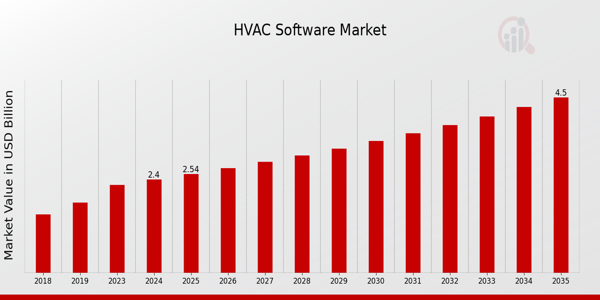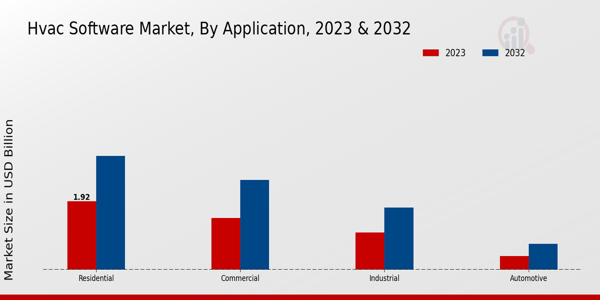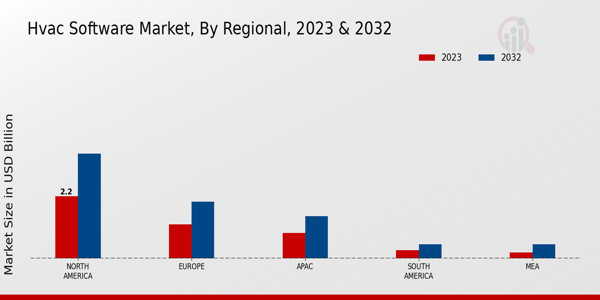HVAC Software Market Overview
As per MRFR analysis, the HVAC Software Market Size was estimated at 2.26 (USD Billion) in 2023.The HVAC Software Market Industry is expected to grow from 2.4(USD Billion) in 2024 to 4.5 (USD Billion) by 2035. The HVAC Software Market CAGR (growth rate) is expected to be around 5.89% during the forecast period (2025 - 2035)
Key HVAC Software Market Trends Highlighted
Several major trends in the Global HVAC Software Market reflect changing industry demands. HVAC systems show a clear trend toward automation and artificial intelligence (AI) integration. Key market drivers include operational costs, predictive maintenance, and efficiency improvements brought on by these developments. Demand for energy-efficient systems is driving businesses to use HVAC software that can maximize energy use and follow rules. The increasing focus on sustainability is also opening doors for software solutions that provide improved energy management and reporting capabilities, hence attracting eco-conscious companies and consumers.
Latest trends show more use of cloud-based HVAC software, which enables remote monitoring and real-time data access. Catering to the changing needs of several industries, including commercial structures, residential properties, and industrial environments, this technical development promotes flexibility and scalability. Moreover, the movement toward smart building technologies and the integration of the Internet of Things (IoT) is creating possibilities for creative software applications, improving user experience and operational efficiency. Furthermore, the HVAC software industry is set to seize new prospects as government agencies all over the world strive for more stringent energy efficiency criteria and environmental practices.
Industry professionals are urged to use sophisticated analytics and machine learning tools to promote improved decision-making processes. These developments not only reflect shifts in consumer tastes but also underline the need to constantly adapt to recent technology and market realities in the HVAC industry.

Source: Primary Research, Secondary Research, MRFR Database and Analyst Review
HVAC Software Market Drivers
Technological Advancements in HVAC Systems
Rapid technical developments in HVAC systems are driving the notable expansion of the Global HVAC Software Market Industry. HVAC software is becoming increasingly appealing for adoption as technologies like machine learning, the Internet of Things (IoT), and artificial intelligence (AI) improve its efficiency and effectiveness. The Global Alliance of Energy Efficiency (GAEE) estimates that HVAC systems use around 40% of the energy in commercial structures.
Improvements in HVAC software will enable more efficient energy management, lower running expenses, and less environmental effect as governments and companies all over stress energy efficiency. For example, businesses like Johnson Controls International plc are arming their HVAC systems with IoT capabilities and sophisticated analytics, which are vital in satisfying the increased need for energy-efficient systems. Rising energy rules and environmental projects in many nations drive this trend as well as help the Global HVAC Software Market to expand, thus rendering effective HVAC software really necessary.
Increasing Demand for Energy Efficiency
The worldwide focus on energy efficiency and sustainability is driving growing interest in the Global HVAC Software Market Industry. According to the International Energy Agency, energy-efficient buildings might assist in reducing worldwide greenhouse gas emissions by as much as 50%. HVAC software that maximizes energy use is very necessary as companies seek to follow tight energy rules and save running expenses. Trane Technologies and other businesses have been aggressive in including energy-efficient features in their HVAC products, hence helping companies to reduce energy expenses by as much as 30%.
The need for strong HVAC software will increase as the linked character of energy policy globally develops, hence influencing the market directly.
Expansion of Smart Buildings
Another major factor for the Global HVAC Software Market Industry is the rising worldwide development of smart buildings. Smart buildings use cutting-edge technology to maximize performance and improve residents' quality of life. The Building and Sector Council estimates that, depending on the use of intelligent HVAC systems with software for real-time monitoring and changes, smart buildings might save energy use by 10-30%.
Leading businesses such as Honeywell International Inc. are creating HVAC software solutions that fit smoothly into different smart building systems, hence increasing demand. The industry is probably going to expand faster as more companies put money into smart infrastructure, including HVAC systems with improved software features.
HVAC Software Market Segment Insights
HVAC Software Market Application Insights
The Global HVAC Software Market is witnessing significant growth in the Application segment, which encompasses various settings including Residential, Commercial, Industrial, and Institutional applications. In 2024, the total market is projected to be valued at 2.4 USD Billion and is set to increase to 4.5 USD Billion by 2035, highlighting a robust demand for HVAC software solutions. Within this segment, the Residential application stands out with a valuation of 0.96 USD Billion in 2024, showing a noteworthy increase to 1.68 USD Billion by 2035.This growth can be attributed to the rising trend of smart home technologies and the increasing emphasis on energy efficiency, making HVAC software solutions critical for homeowners who aim to optimize their energy consumption.
The Commercial segment also plays a crucial role in the market, valued at 0.84 USD Billion in 2024 and expected to rise to 1.44 USD Billion in 2035. This segment is driven by the growing demand for efficient building management systems, which are essential for regulating climate control in large commercial spaces. Meanwhile, the Industrial application, valued at 0.48 USD Billion in 2024 and projected to reach 0.84 USD Billion in 2035, emphasizes the necessity for advanced HVAC solutions to support significant manufacturing processes and optimize operational efficiencies.
Lastly, the Institutional sector, although smaller, valued at 0.12 USD Billion in 2024 with anticipated growth to 0.24 USD Billion by 2035, highlights the essentiality of HVAC software in educational and healthcare facilities where precise temperature control is vital for creating conducive environments for learning and patient care. As the Global HVAC Software Market continues to grow, each application serves as a critical component contributing to the overall market dynamics, supported by technological advancements and rising awareness of the need for energy efficiency across various sectors.

Source: Primary Research, Secondary Research, MRFR Database and Analyst Review
HVAC Software Market Deployment Type Insights
The Global HVAC Software Market shows a diversified approach in its Deployment Type segment, primarily categorized into Cloud Based, On-Premise, and Hybrid solutions. In 2024, the market is anticipated to grow steadily, with an overall valuation reaching 2.4 USD Billion, reflecting the increasing reliance on advanced technologies for HVAC systems. Cloud Based solutions are gaining traction due to their scalability, lower maintenance costs, and easy access to real-time data, making them a preferred choice for many businesses looking to enhance operational efficiency.On-Premise options still hold significance, particularly among larger enterprises with strict data security requirements and those operating on legacy systems, showcasing a robust demand for tailored solutions.
The Hybrid model combines the benefits of both Cloud and On-Premise, facilitating flexibility and a balanced approach to data management. This diversification in deployment types addresses varied customer needs and regulatory requirements across the Global HVAC Software Market, enabling stakeholders to strategize effectively. As the industry evolves, the growth drivers include increasing energy efficiency mandates and enhanced building automation technologies, while challenges encompass high initial investment costs and fragmented market players.The ongoing evolution in deployment types presents numerous opportunities for innovative solutions that can significantly enhance user experience and operational capabilities.
HVAC Software Market Functionality Insights
The Global HVAC Software Market has shown significant growth with a projected overall valuation of 2.4 billion USD in 2024 and is expected to further increase over the years. This market segmentation focuses on functionality, which plays a critical role in enhancing the operational efficiency of HVAC systems. Within this segment, Control Systems facilitate the automation of HVAC processes, leading to improved comfort and energy savings. Energy Management capabilities are crucial, allowing businesses to track and optimize energy usage effectively.Maintenance Management helps in minimizing downtime and prolonging equipment lifespan.
Additionally, Design and Simulation tools are essential for engineers and architects in planning and optimizing HVAC systems for new constructions. As industries increasingly prioritize energy efficiency and sustainability, the demand for HVAC software functionalities like these continues to rise, significantly impacting the overall market growth. The Global HVAC Software Market data evidences a strong trend towards digitization and smart technology integration, driving this segment's expansion.Market statistics reveal that innovations in software solutions directly address the challenges of reducing operational costs and enhancing system performance, solidifying their importance in the industry's evolution.
HVAC Software Market End Use Insights
The Global HVAC Software Market is projected to be valued at 2.4 billion USD by 2024, showcasing substantial growth driven by increasing demand for optimized energy consumption and improved indoor climate control across various sectors. Within the End Use segment, industries such as Retail, Healthcare, Education, and Hospitality are instrumental in shaping market dynamics. Retail establishments utilize HVAC software to manage energy costs and enhance customer comfort, leading to a better shopping experience. The Healthcare sector emphasizes energy efficiency and air quality, making effective HVAC management critical for patient safety and operational efficiency.
In Education, HVAC solutions support climate control essential for creating conducive learning environments, while Hospitality venues focus on delivering superior guest experiences through precise HVAC management. The synergy between these sectors and HVAC solutions amplifies the importance of effective environmental controls, driving market growth. The increasing awareness of energy-efficient solutions and regulatory compliance within these industries marks a significant opportunity for the Global HVAC Software Market, highlighting its necessity in achieving sustainability goals and operational efficiency across multiple applications.
HVAC Software Market Regional Insights
The Global HVAC Software Market is poised for significant growth across various regions, with North America leading the way with a valuation of 0.96 USD Billion in 2024, projected to increase to 1.8 USD Billion by 2035, showcasing the region's majority holding in the market. Europe follows with a valuation of 0.72 USD Billion in 2024 and an increase to 1.3 USD Billion by 2035, benefiting from stringent energy efficiency regulations and advancements in building automation. The APAC region, valued at 0.48 USD Billion in 2024 and expected to grow to 0.9 USD Billion by 2035, is gaining traction due to rapid industrialization and urbanization trends, reflecting its growing significance in the Global HVAC Software Market data.
In contrast,South America and the Middle East and Africa (MEA) both hold a smaller market share, valued at 0.12 USD Billion each in 2024, expected to reach 0.25 USD Billion by 2035, indicating their emerging potential but limited impact currently on the overall market growth. The diverse needs for energy-efficient solutions and smart technologies across these regions create ample opportunities, although market challenges remain due to varying legislative environments and development stages. This variation across the regions not only influences Global HVAC Software Market statistics but also reflects the regional strategic importance in the evolving landscape of HVAC technologies.

Source: Primary Research, Secondary Research, MRFR Database and Analyst Review
HVAC Software Market Key Players and Competitive Insights
The Global HVAC Software Market has seen significant growth driven by increasing demand for energy-efficient and smart building solutions. As companies strive for greater operational efficiency and sustainability, HVAC software has emerged as a critical component in managing heating, ventilation, and air conditioning processes. The competitive landscape is characterized by a mix of established players and innovative startups, all vying for market share through technological advancements and comprehensive service offerings. The market is being shaped by trends such as the integration of artificial intelligence, IoT, and cloud-based solutions, enabling businesses to optimize system performance, reduce costs, and enhance customer satisfaction.
As companies adapt to changing regulations and preferences, understanding competitive dynamics is crucial for identifying opportunities and challenges within the market.Trane Technologies stands out in the Global HVAC Software Market due to its strong reputation for delivering reliable and intelligent HVAC solutions. The company focuses heavily on innovation, fostering a robust research and development environment that yields cutting-edge technologies in energy management and HVAC automation. Trane Technologies maintains a significant global presence, which allows it to cater to a diverse clientele across various sectors, including commercial, residential, and industrial. The company's strengths lie in its extensive product portfolio, which features advanced software solutions for system diagnostics, energy efficiency, and predictive maintenance.
Furthermore, Trane Technologies has built strong partnerships and alliances that enhance its market reach and enable it to provide comprehensive service offerings tailored to specific industry needs.Visier has carved a niche within the Global HVAC Software Market by providing intuitive, data-driven analytics solutions that aid in strategic decision-making for HVAC operations. The company’s key products focus on enhancing operational efficiency and enabling data visualization to drive informed management choices, thereby improving overall system performance. Visier's strength lies in its ability to offer powerful insights and predictive analytics that cater to the specific needs of HVAC sectors worldwide.
With a strategic emphasis on global expansion, Visier has navigated collaborations and mergers that bolster its technological integration and enhance its presence in the competitive landscape. By leveraging its data-centric approach and fostering robust client relationships, Visier is positioned to capture market trends precisely and effectively address the evolving requirements of the HVAC industry.
Key Companies in the HVAC Software Market Include
- Trane Technologies
- Visier
- Lennox International
- Energy Star
- Capterra
- AccuWeather
- Johnson Controls
- Schneider Electric
- Daikin Industries
- Automated Logic
- Enercare
- Honeywell
- Siemens
- Mitsubishi Electric
- Carrier Global
HVAC Software Market Industry Developments
In recent months, key developments in the Global HVAC Software Market have showcased significant advancements and strategic movements among major players. Trane Technologies and Johnson Controls have been focusing on enhancing their software solutions to improve energy efficiency and operational effectiveness for HVAC systems. In July 2023, Schneider Electric announced the expansion of its EcoStruxure platform, which integrates HVAC management with IoT technologies to optimize building operations. Notably, in August 2023, Mitsubishi Electric revealed a collaboration with Daikin Industries to develop advanced climate control solutions that leverage AI for predictive maintenance.
The market has been witnessing notable growth, attributed to increasing awareness of energy conservation and stricter building regulations globally. Companies like Honeywell and Siemens have reported an uptick in their market valuations due to a surge in demand for smart HVAC solutions. Additionally, in September 2023, Carrier Global made headlines with its acquisition of an innovative HVAC software startup, indicating a wave of consolidation in the market driven by technological advancements. The trend towards sustainability and automation continues to reshape the competitive landscape of the Global HVAC Software Market.
HVAC Software Market Segmentation Insights
- HVAC Software Market Application Outlook
- Residential
- Commercial
- Industrial
- Institutional
- HVAC Software Market Deployment Type Outlook
- Cloud Based
- On-Premise
- Hybrid
- HVAC Software Market Functionality Outlook
- Control Systems
- Energy Management
- Maintenance Management
- Design and Simulation
- HVAC Software Market End Use Outlook
- Retail
- Healthcare
- Education
- Hospitality
- HVAC Software Market Regional Outlook
- North America
- Europe
- South America
- Asia Pacific
- Middle East and Africa
| Report Attribute/Metric Source: |
Details |
| MARKET SIZE 2023 |
2.26(USD Billion) |
| MARKET SIZE 2024 |
2.4(USD Billion) |
| MARKET SIZE 2035 |
4.5(USD Billion) |
| COMPOUND ANNUAL GROWTH RATE (CAGR) |
5.89% (2025 - 2035) |
| REPORT COVERAGE |
Revenue Forecast, Competitive Landscape, Growth Factors, and Trends |
| BASE YEAR |
2024 |
| MARKET FORECAST PERIOD |
2025 - 2035 |
| HISTORICAL DATA |
2019 - 2024 |
| MARKET FORECAST UNITS |
USD Billion |
| KEY COMPANIES PROFILED |
Trane Technologies, Visier, Lennox International, Energy Star, Capterra, AccuWeather, Johnson Controls, Schneider Electric, Daikin Industries, Automated Logic, Enercare, Honeywell, Siemens, Mitsubishi Electric, Carrier Global |
| SEGMENTS COVERED |
Application, Deployment Type, Functionality, End Use, Regional |
| KEY MARKET OPPORTUNITIES |
Smart building integration, Increased energy efficiency demand, Growth in IoT applications, Rising focus on sustainability, Enhanced predictive maintenance solutions |
| KEY MARKET DYNAMICS |
Technological advancements, Increasing energy efficiency regulations, Growing demand for automation, Rising importance of predictive maintenance, Expanding cloud-based solutions |
| COUNTRIES COVERED |
North America, Europe, APAC, South America, MEA |
Frequently Asked Questions (FAQ) :
The Global HVAC Software Market is expected to be valued at 2.4 USD Billion in 2024.
The expected CAGR for the Global HVAC Software Market from 2025 to 2035 is 5.89%.
By 2035, North America is predicted to have the largest market value in the Global HVAC Software Market at 1.8 USD Billion.
The Residential application segment is expected to be valued at 1.68 USD Billion in 2035.
The market value for the Commercial application segment in 2024 was 0.84 USD Billion.
The Industrial application segment is projected to reach 0.84 USD Billion by 2035.
Major players in the Global HVAC Software Market include Trane Technologies, Lennox International, Johnson Controls, and Honeywell.
By 2035, the HVAC Software Market in the APAC region is expected to be valued at 0.9 USD Billion.
The Institutional application segment is expected to be valued at 0.12 USD Billion in 2024.
The anticipated value of the HVAC Software Market in Europe by 2035 is 1.3 USD Billion.

















